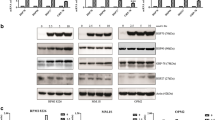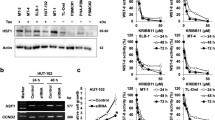Summary
The prognosis of patients with Philadelphia chromosome-positive (Ph+) acute lymphoblastic leukemia (ALL) is poor. Chemotherapy is rarely curative and tyrosine kinase inhibitors (TKIs) induce only transient responses. Heat shock protein 90 (Hsp90) is a chaperone protein that is important in signal transduction, cell cycle control, and transcription regulation in both normal and leukemia cells. In the current study, we tested the growth inhibitory and apoptotic effects of a novel Hsp90 inhibitor, EC141 on the Ph+ ALL lines Z-119, Z-181, and Z-33, as well as primary bone marrow-derived blasts from patients with newly diagnosed Ph+ ALL. We found that EC141 inhibited the growth of Ph+ ALL cells in a concentration-dependent manner with IC50 ranged from 1 to 10 nM. EC141 also inhibited the proliferation of primary bone marrow-derived blasts using the ALL blast colony assay. EC141 down-regulated Hsp90 and up-regulated Hsp70 protein levels, inhibited CrkL phosphorylation, and induced degradation of Bcr-Abl p190 protein through ubiquitin-dependent proteasomal pathway. Furthermore, exposure of Ph+ ALL cells to EC141 resulted in activation of caspase-3, cleavage of poly (ADP-ribose) polymerase (PARP), and induction of apoptosis. In conclusion, our data suggest that EC141 is a potent Hsp90 inhibitor with activity against Ph+ ALL. Further studies to investigate the anticancer effect of EC141 either as a single agent, or in combination in Ph+ ALL and other hematological malignancies are warranted.






Similar content being viewed by others
References
Lugo TG, Pendergast AM, Muller AJ, Witte ON (1990) Tyrosine kinase activity and transformation potency of bcr-abl oncogene products. Science 247:1079–1082
Faderl S, Kantarjian HM, Talpaz M, Estrov Z (1998) Clinical significance of cytogenetic abnormalities in adult acute lymphoblastic leukemia. Blood 91:3995–4019
Larson RA (2006) Management of acute lymphoblastic leukemia in older patients. Semin Hematol 43:126–133
Thomas DA (2007) Philadelphia chromosome positive acute lymphocytic leukemia: a new era of challenges. Hematology Am Soc Hematol Educ Program 2007:435–443
Voncken JW, Kaartinen V, Pattengale PK, Germeraad WT, Groffen J, Heisterkamp N (1995) BCR/ABL P210 and P190 cause distinct leukemia in transgenic mice. Blood 86:4603–4611
Faderl S, Kantarjian HM, Thomas DA (2000) Outcome of Philadelphia chromosome-positive adult acute lymphoblastic leukemia. Leuk Lymphoma 36:263–273
Dombret H, Gabert J, Boiron JM (2002) Outcome of treatment in adults with Philadelphia chromosome-positive acute lymphoblastic leukemia-results of the prospective multicenter LALA-94 trial. Blood 100:2357–2366
Druker BJ, Sawyers CL, Kantarjian H (2001) Activity of a specific inhibitor of the BCR-ABL tyrosine kinase in the blast crisis of chronic myeloid leukemia and acute lymphoblastic leukemia with the Philadelphia chromosome. N Engl J Med 344:1038–1042
Thomas DA, Faderl S, Cortes J, Kantarjian HM (2004) Treatment of Philadelphia chromosome-positive acute lymphocytic leukemia with hyper-CVAD and imatinib mesylate. Blood 103:4396–4407
Gorre ME, Mohammed M, Ellwood K (2001) Clinical resistance to STI-571 cancer therapy caused by BCR-ABL gene mutation or amplification. Science 293:876–880
Shah NP, Nicoll JM, Nagar B (2002) Multiple BCR-ABL kinase domain mutations confer polyclonal resistance to the tyrosine kinase inhibitor imatinib (STI571) in chronic phase and blast crisis chronic myeloid leukemia. Cancer Cell 2:117–125
Welch WJ, Feramisco JR (1982) Purification of the major mammalian heat shock proteins. J Biol Chem 257:14949–14959
Workman P, Burrows F, Neckers L, Rosen N (2007) Drugging the cancer chaperone HSP90: combinatorial therapeutic exploitation of oncogene addiction and tumor stress. Ann NY Acad Sci 1113:202–216
Banerji U (2009) Heat shock protein 90 as a drug target: some like it hot. Clin Cancer Res 15:9–14
Isaacs JS, Xu W, Neckers L (2003) Heat shock protein 90 as a molecular target for cancer therapeutics. Cancer Cell 3:213–217
Williams CR, Tabios R, Linehan WM, Neckers L (2007) Intratumor injection of the Hsp90 inhibitor 17AAG decreases tumor growth and induces apoptosis in a prostate cancer xenograft model. J Urol 178:1528–1532
Estrov Z, Talpaz M, Zipf TF (1996) Role of granulocyte-macrophage colony-stimulating factor in Philadelphia (Ph1)-positive acute lymphoblastic leukemia: studies on two newly established Ph1-positive acute lymphoblastic leukemia cell lines (Z-119 and Z-181). J Cell Physiol 166:618–630
Estrov Z, Talpaz M, Ku S (1996) Molecular and biologic characterization of a newly established Philadelphia-positive acute lymphoblastic leukemia cell line (Z-33) with an autocrine response to GM-CSF. Leukemia 10:1534–1543
Estrov Z, Manna SK, Harris D (1999) Phenylarsine oxide blocks interleukin-1beta-induced activation of the nuclear transcription factor NF-kappaB, inhibits proliferation, and induces apoptosis of acute myelogenous leukemia cells. Blood 94:2844–2853
Faderl S, Lotan R, Kantarjian HM, Harris D, Van Q, Estrov Z (2003) N-(4-Hydroxylphenyl)retinamide (fenretinide, 4-HPR), a retinoid compound with antileukemic and proapoptotic activity in acute lymphoblastic leukemia (ALL). Leuk Res 27:259–266
Roberts WM, Estrov Z, Ouspenskaia MV, Johnston DA, McClain KL, Zipf TF (1997) Measurement of residual leukemia during remission in childhood acute lymphoblastic leukemia. N Engl J Med 336:317–323
Johnson AJ, Wagner AJ, Cheney CM (2007) Rituximab and 17-allylamino-17-demethoxygeldanamycin induce synergistic apoptosis in B-cell chronic lymphocytic leukaemia. Br J Haematol 139:837–844
Radujkovic A, Schad M, Topaly J (2005) Synergistic activity of imatinib and 17-AAG in imatinib-resistant CML cells overexpressing BCR-ABL-Inhibition of P-glycoprotein function by 17-AAG. Leukemia 19:1198–1206
Wu LX, Xu JH, Zhang KZ (2008) Disruption of the Bcr-Abl/Hsp90 protein complex: a possible mechanism to inhibit Bcr-Abl-positive human leukemic blasts by novobiocin. Leukemia 22:1402–1409
Neckers L (2007) Heat shock protein 90: the cancer chaperone. J Biosci 32:517–530
Solit DB, Osman I, Polsky D (2008) Phase II trial of 17-allylamino-17-demethoxygeldanamycin in patients with metastatic melanoma. Clin Cancer Res 14:8302–8307
Neckers L (2002) Heat shock protein 90 is a rational molecular target in breast cancer. Breast Dis 15:53–60
George P, Bali P, Annvarapu S (2005) Combination of the histone deacetylase inhibitor LBH589 and the hsp90 inhibitor 17-AAG is highly active against human CML-BC cells and AML cells with activating mutation of the FLT-3. Blood 105:1768–1776
Mesa RA, Loegering D, Powell HL (2005) Heat shock protein 90 inhibition sensitizes acute myelogenous leukemia cells to cytarabine. Blood 106:318–327
Acknowledgments
We thank Biogen Idec. for providing EC141 for these studies, and Donald R. Norwood from the Department of Scientific Publication at the M.D. Anderson Cancer Center for editing the manuscript.
Disclosure of Potential Conflicts of Interest
There is no conflict of interest to disclose.
Author information
Authors and Affiliations
Corresponding author
Rights and permissions
About this article
Cite this article
Tong, WG., Estrov, Z., Wang, Y. et al. The synthetic heat shock protein 90 (Hsp90) inhibitor EC141 induces degradation of Bcr-Abl p190 protein and apoptosis of Ph-positive acute lymphoblastic leukemia cells. Invest New Drugs 29, 1206–1212 (2011). https://doi.org/10.1007/s10637-010-9465-8
Received:
Accepted:
Published:
Issue Date:
DOI: https://doi.org/10.1007/s10637-010-9465-8




